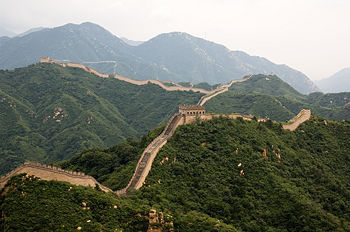Great Wall of China: Difference between revisions
imported>Bruce M. Tindall mNo edit summary |
imported>Bruce M. Tindall mNo edit summary |
||
| Line 2: | Line 2: | ||
[[Image:Great Wall of China.jpg|right|thumb|350px|{{#ifexist:Template:Great Wall of China.jpg/credit| | [[Image:Great Wall of China.jpg|right|thumb|350px|{{#ifexist:Template:Great Wall of China.jpg/credit| | ||
{{Great Wall of China.jpg/credit}}<br/>|}}A section of the Great Wall.]] | {{Great Wall of China.jpg/credit}}<br/>|}}A section of the Great Wall.]] | ||
The '''Great Wall of China''', known to the Chinese as The Long Wall of 10,000 Li ([[Pinyin]]: ''Wànlǐ Chángchéng'') is emblematic of China. This UNESCO World Heritage Site<ref>http://whc.unesco.org/en/list/438</ref> has a history which dates back over two thousand five hundred years. It is now a major tourist attraction with sections of the wall being restored for this purpose - especially near Beijing. The total length of the wall is unknown. Its size, age, complexity and general state of disrepair mean that new sections of wall are still being identified and some sections my yet await discovery. In its last incarnation, during the Ming Dynasty, the wall reached its zenith in building quality and length measuring 5,650 km<ref>http://whc.unesco.org/archive/advisory_body_evaluation/438.pdf</ref> and crossing 17 provinces in North and | The '''Great Wall of China''', known to the Chinese as The Long Wall of 10,000 Li ([[Pinyin]]: ''Wànlǐ Chángchéng'') is emblematic of China. This UNESCO World Heritage Site<ref>http://whc.unesco.org/en/list/438</ref> has a history which dates back over two thousand five hundred years. It is now a major tourist attraction with sections of the wall being restored for this purpose - especially near Beijing. The total length of the wall is unknown. Its size, age, complexity and general state of disrepair mean that new sections of wall are still being identified and some sections my yet await discovery. In its last incarnation, during the Ming Dynasty, the wall reached its zenith in building quality and length measuring 5,650 km<ref>http://whc.unesco.org/archive/advisory_body_evaluation/438.pdf</ref> and crossing 17 provinces in North and Central China. | ||
==History== | ==History== | ||
Revision as of 13:10, 6 December 2007
The Great Wall of China, known to the Chinese as The Long Wall of 10,000 Li (Pinyin: Wànlǐ Chángchéng) is emblematic of China. This UNESCO World Heritage Site[1] has a history which dates back over two thousand five hundred years. It is now a major tourist attraction with sections of the wall being restored for this purpose - especially near Beijing. The total length of the wall is unknown. Its size, age, complexity and general state of disrepair mean that new sections of wall are still being identified and some sections my yet await discovery. In its last incarnation, during the Ming Dynasty, the wall reached its zenith in building quality and length measuring 5,650 km[2] and crossing 17 provinces in North and Central China.
History
The wall's construction began during the Warring States Period, which lasted from 403 to 221 BC. Qin Shi Huang, establisher and first emperor of the Qin dynasty, erected the largest portion of the wall as a defense against attacks by nomadic peoples. Real work on the wall began in 221 BC, after Shi Huang had united China under his rule, and it was finished in 204 BC. Small sections of the wall already existed, but Huang had nearly 2,000 km of the wall built during his reign. More than 300,000 men worked connecting the segments into a single, huge wall of stone and earth. During the Ming Dynasty of 1368 to 1644 AD, interest in the Great Wall was revived, and it was repaired and extended, this time reinforced with cement and stone. [3]
